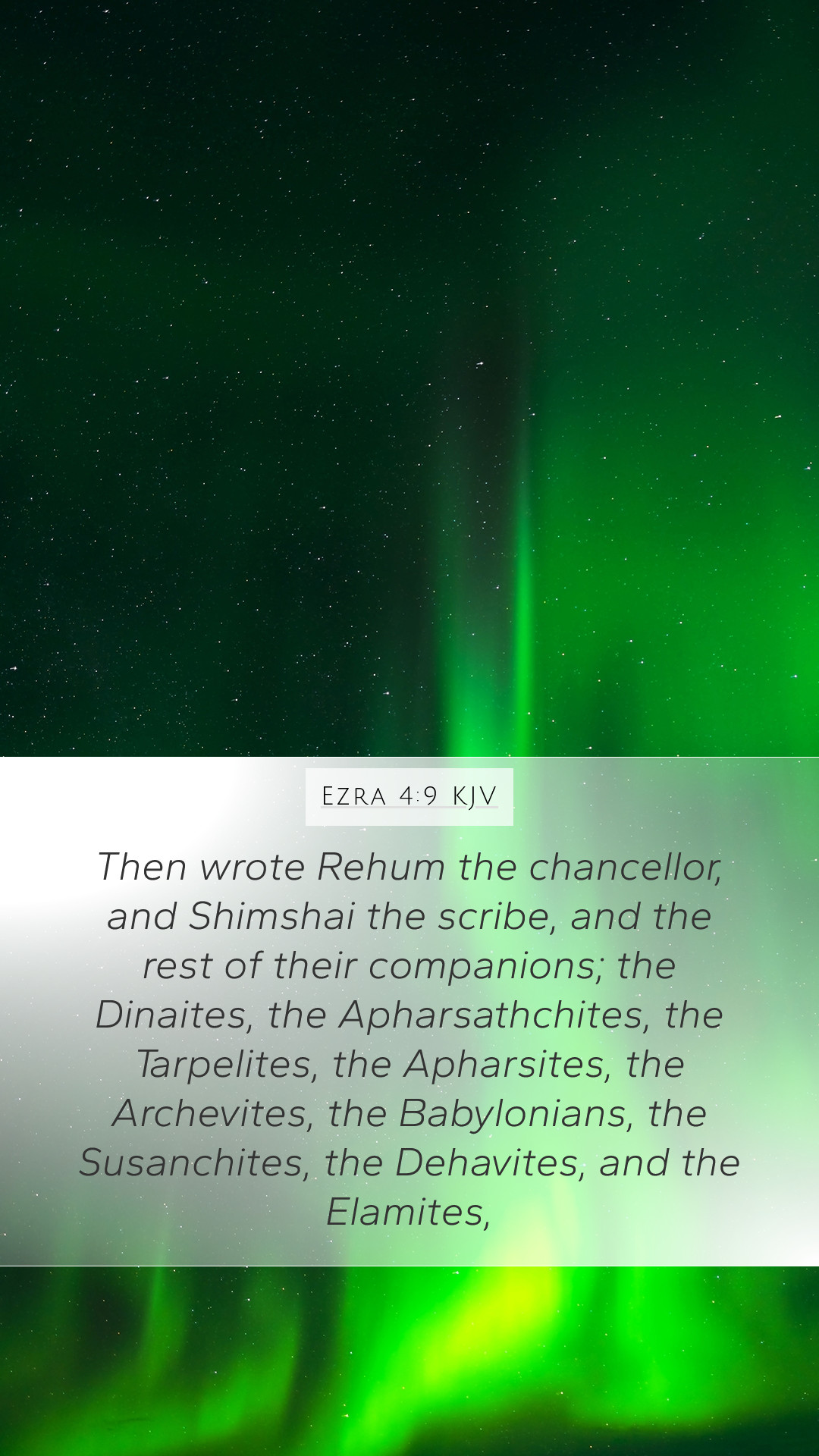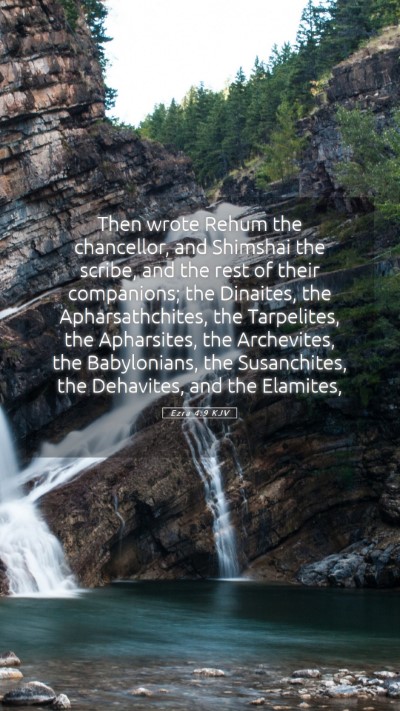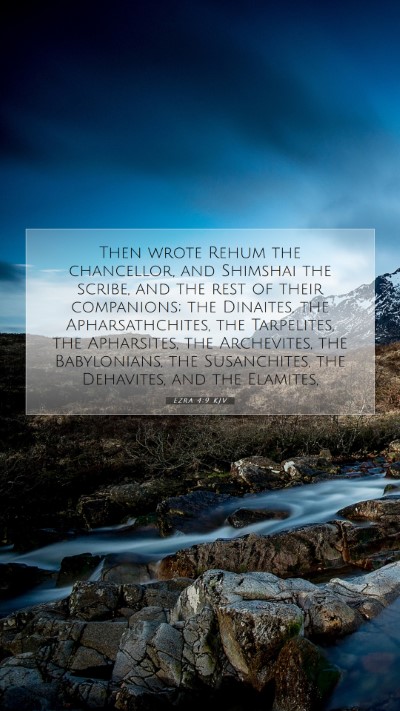Old Testament
Genesis Exodus Leviticus Numbers Deuteronomy Joshua Judges Ruth 1 Samuel 2 Samuel 1 Kings 2 Kings 1 Chronicles 2 Chronicles Ezra Nehemiah Esther Job Psalms Proverbs Ecclesiastes Song of Solomon Isaiah Jeremiah Lamentations Ezekiel Daniel Hosea Joel Amos Obadiah Jonah Micah Nahum Habakkuk Zephaniah Haggai Zechariah MalachiEzra 4:9 Meaning
What is the meaning of Ezra 4:9?
Then wrote Rehum the chancellor, and Shimshai the scribe, and the rest of their companions; the Dinaites, the Apharsathchites, the Tarpelites, the Apharsites, the Archevites, the Babylonians, the Susanchites, the Dehavites, and the Elamites,
Ezra 4:9 Bible Verse Meaning
Meaning and Commentary on Ezra 4:9
Ezra 4:9 states, "Then wrote Rehum the chancellor, and Shimshai the scribe, and the rest of their companions, the Dinaites, the Apharsathchites, the Tarpalites, the people of Persia, and the people of Erech, and the people of Babylon, and the men of Susa, and the rest of the nations whom the great and noble Asnapper brought over and settled in the city of Samaria, and the rest that are on this side the river, and at such a time."
Summary of Ezra 4:9
This verse introduces the correspondence from leaders and officials who opposed the rebuilding of Jerusalem's temple and walls. The context reveals tensions between the returning Jewish exiles and the Samaritans, who sought to hinder the restoration efforts. The multitude of nations mentioned underscores the diverse opposition faced by the Jewish returnees.
Insights from Public Domain Commentaries
Matthew Henry's Commentary
Matthew Henry notes that this correspondence represents the formal opposition the Jews encountered when they attempted to rebuild their city after returning from exile. He emphasizes the organized effort by the surrounding nations to disrupt God's work through the Israelites. The names of various groups illustrate the widespread nature of this resistance.
Albert Barnes' Notes on the Bible
Albert Barnes provides a detailed analysis, pointing out that these officials represented a coalition of various ethnic groups and that they attempted to align themselves with the Persian authorities against the Jews. This reflects the political intrigue of the time, where local leaders sought to retain power by maintaining the status quo hindered by the rebuilding efforts.
Adam Clarke's Commentary
Adam Clarke highlights the role of Asnapper, suggesting that he may have been a historical figure influencing these nations' settlement. Clarke explains that the presence of such diverse peoples illustrates the broader socio-political issues facing the Israelites. He argues that understanding this context is vital for grasping the challenges involved in their return and restoration.
Understanding Scripture and Historical Context
The conflict highlighted in Ezra 4:9 serves as an essential backdrop for biblical study. Understanding the historical context of the post-exilic community helps illuminate the significance of this verse:
- Rebuilding Efforts: The Jewish people returned to Jerusalem with the divine mission to rebuild the temple and restore their worship.
- Opposition: As they endeavored to fulfill God's plan, they faced opposition from neighboring nations, reflecting the spiritual battle inherent in any divine assignment.
- Political Dynamics: The melding of nationalities and political agendas demonstrates the complexities surrounding the Jewish return and the implications for faith and practice.
Application of Ezra 4:9
For contemporary readers, Ezra 4:9 serves as a profound reminder of the opposition we may encounter when pursuing God's plans. It reinforces the necessity of faith, unity among believers, and reliance on God's sovereignty in the face of challenges.
Related Cross References
- Ezra 3:3: "And they set the altar upon his bases; for fear was upon them because of the people of those countries..." - Discusses the initial fears of the Jews amidst external threats.
- Nehemiah 2:10: "When Sanballat the Horonite, and Tobiah the servant, the Ammonite, heard of it, it grieved them exceedingly..." - Indicates the persistent opposition faced later during Nehemiah's rebuilding efforts.
- Isaiah 54:17: "No weapon that is formed against thee shall prosper..." - A reassurance of God’s protective promise in the face of opposition.
Conclusion
In summary, Ezra 4:9 not only relates a historical account but also provides valuable Bible verse interpretations and Bible verse explanations for understanding the challenges faced by the Jewish exiles. This verse calls believers today to acknowledge the potential for discord while remaining steadfast in faith and purpose, thereby enriching our Bible study insights and guiding our Biblical exegesis.
By delving into chapters like this, individuals and Bible study groups can uncover deeper meanings and applications for personal spiritual growth and communal faith practices.


